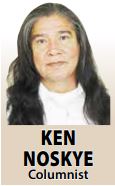
There’s a gravel road about the length of a football field that runs in front of my place.
Along one side of the road is a row of houses. Across the road are evergreen spruce trees. Some of the trees are more than 100 feet tall. If the wind is strong enough, the trees appear to be dancing.
Past me, the road leads to a giant cul-de-sac. Ahead of me, the road leads to a beautiful lake.
My daily fulfillment comes from going on long walks along the lake. It is especially nice at this time of the year when Mother Earth takes a fine paint brush over the trees that grow along the lake.
On my side of the lake, the banks are similar to the banks of the South Saskatchewan River; about the height of the banks along the Broadway area. This is my home reserve. Parts of my childhood were spent swimming at this lake.
My front window faces east. Past the tall evergreens, I watch the sun rise. At times the rising of the sun appears time lapsed, layer upon layer of light pastel colours, until it brings the shadows of the trees into my home. From the same window, I can see my neighbours’ children and grandchildren waiting for the school bus.
Since the school on my reserve goes to Grade 9, students attending high school are bused to the closest town. Two separate buses pick up students and a very small school bus picks up children attending the head-start program, which is like kindergarten.
I get a kick out of one little boy who refuses to get off the bus when it stops for him. His mother has to go into the bus to carry him off. It’s not that he’s crying or anything, but he wants to continue with his classes at the head-start. School and education have evolved in so many ways since I started school.
Having been raised on a northern trapline, I didn’t know what a school was until I was eight. That’s when my family was forced to move from a traditional lifestyle and onto my reserve.
I was terrified because both my parents attended an Indian residential school, and here I was on my way to one.
I was lucky in some ways because the concept of residential schools was being phased out, and my stay in one was only two months. I have a vivid memory of the school being fenced off. There was another small school close by, which was attended by non-status Indians, Métis and the children of the white families.
Through the fence, I could see the kids with nice clothes. We were made to wear uniforms that felt like they were made from horse blankets.
After two months, I was told I would be going to school with the kids on the other side of the fence. It was called a day school, and again I was scared because I didn’t have any of the nice clothes the other kids had. But my mother made sure I had something.
My first school “bus” was a wagon pulled by a couple of horses. I used to look forward to the ride as the horses had bells that chimed along. From the day school, I got bused to town and there would begin another world of education. That education continues on a daily basis today. I have lived on this same site for eight years now and I have seen many of the youth grow up.
Their future is limitless, and their dreams and ambitions are realistic. I am proud of the youth on my nation. One hears too many negative stories about Indigenous youth, instead of seeing the potential those young people have. Yes, there are some who are caught in some form of vicious cycle, but there are also those who step up.
The youth today have more many struggles than I did. I thought I had rough because I had a Tenderflake lard pail with holes punched on the lid as my lunch kit, while the other kids had Superman, Batman or other comic book superheroes. More and more Indigenous youth are now attending post-secondary schools, and I have complete confidence in them to carry on the Cree traditions.
Seeing those yellow school buses picking up students is inspiring. I often think of those who were robbed of an education, like my parents who attended residential school from preschool age to their mid-teens, only to come out with maybe a Grade 2 level because they were forced to work all day.
Now people know how 400 kids were fed — by using other kids as labour. I also think of those who revolutionized Indigenous education; many are still at it today.
Those buses filled with Indigenous youth are paving a future with boundaries limited to their imaginations. But they will never get the thrill of being pulled by a horse team.
-Ken Noskye
